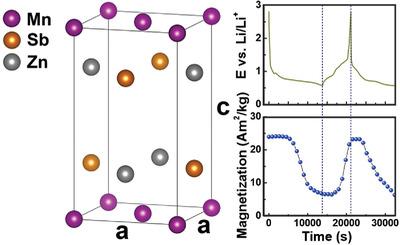当前位置:
X-MOL 学术
›
Adv. Electron. Mater.
›
论文详情
Our official English website, www.x-mol.net, welcomes your feedback! (Note: you will need to create a separate account there.)
Electric‐Potential‐Induced Complete Control of Magnetization in MnZnSb Metallic Ferromagnets
Advanced Electronic Materials ( IF 6.2 ) Pub Date : 2020-12-04 , DOI: 10.1002/aelm.202000790 Martin Møller Greve 1, 2 , Bijoy Das 1, 3 , Ibrahim Issac 1 , Ralf Witte 1 , Di Wang 1, 4 , Robert Kruk 1 , Horst Hahn 1 , Subho Dasgupta 1, 5
Advanced Electronic Materials ( IF 6.2 ) Pub Date : 2020-12-04 , DOI: 10.1002/aelm.202000790 Martin Møller Greve 1, 2 , Bijoy Das 1, 3 , Ibrahim Issac 1 , Ralf Witte 1 , Di Wang 1, 4 , Robert Kruk 1 , Horst Hahn 1 , Subho Dasgupta 1, 5
Affiliation

|
Magnetoelectric coupling refers to electric‐field control of magnetism, which may offer low‐power memory and beyond‐CMOS electronics. However, contenders of magnetic phase change materials, such as the dilute magnetic semiconductors (DMS), show weak ferromagnetism whereas the ultra‐small screening lengths of robust metallic magnets in artificially stacked thin film heterostructures reduce the extent of controllable magnetization to sub‐atomic distances, thereby diminishing the sheer magnitude of the tunable magnetization. In contrast, an electrochemical control of magnetization has recently been proposed where reversible electrochemistry/ion‐exchange is used to control magnetism in bulk ferromagnets. However, so far, ionic control of magnetism is limited to spinel ferrites and highly correlated oxide systems. Here, it is reported that the ionic control of magnetism can be extended to metallic ferromagnets; complete and reversible switching of ferromagnetism is demonstrated in bulk MnZnSb intermetallic compounds at room temperature. An electrochemically controlled reversible tuning of magnetization across the magnetic phase transition temperature is demonstrated. The observed phenomenon can be explained by the distortion of the crystal lattice, upon Li‐ion insertion into the MnZnSb interstitial sites, accompanied by a change in the magnetic moment of the manganese ions; acting together, both these effects lead to the collapse of the ferromagnetic order in MnZnSb.
中文翻译:

MnZnSb金属铁磁体的电势诱导磁化完全控制
磁电耦合是指磁场的电场控制,它可以提供低功率存储器和超越CMOS的电子产品。但是,磁性相变材料(例如稀磁半导体(DMS))的竞争者表现出弱的铁磁性,而人工堆叠的薄膜异质结构中坚固的金属磁体的超小屏蔽长度将可控制的磁化程度减小到亚原子距离,从而减小了可调磁化强度的绝对值。相反,最近提出了一种磁化的电化学控制方法,其中可逆电化学/离子交换用于控制大块铁磁体中的磁性。但是,到目前为止,磁性的离子控制仅限于尖晶石铁氧体和高度相关的氧化物体系。这里,据报道,磁性的离子控制可以扩展到金属铁磁体。在室温下,块状MnZnSb金属间化合物证明了铁磁性的完全可逆转换。展示了在整个磁相变温度范围内的电化学控制的可逆磁化调谐。当锂离子插入MnZnSb间隙位置时,伴随着锰离子磁矩的变化,观察到的现象可以用晶格畸变来解释。这两个效应共同作用会导致MnZnSb中铁磁序的崩溃。展示了在整个磁相变温度范围内的电化学控制的可逆磁化调谐。当锂离子插入MnZnSb间隙位置时,伴随着锰离子磁矩的变化,观察到的现象可以用晶格畸变来解释。这两个效应共同作用会导致MnZnSb中铁磁序的崩溃。展示了在整个磁相变温度范围内的电化学控制的可逆磁化调谐。当锂离子插入MnZnSb间隙位置时,伴随着锰离子磁矩的变化,观察到的现象可以用晶格畸变来解释。这两个效应共同作用会导致MnZnSb中铁磁序的崩溃。
更新日期:2021-01-14
中文翻译:

MnZnSb金属铁磁体的电势诱导磁化完全控制
磁电耦合是指磁场的电场控制,它可以提供低功率存储器和超越CMOS的电子产品。但是,磁性相变材料(例如稀磁半导体(DMS))的竞争者表现出弱的铁磁性,而人工堆叠的薄膜异质结构中坚固的金属磁体的超小屏蔽长度将可控制的磁化程度减小到亚原子距离,从而减小了可调磁化强度的绝对值。相反,最近提出了一种磁化的电化学控制方法,其中可逆电化学/离子交换用于控制大块铁磁体中的磁性。但是,到目前为止,磁性的离子控制仅限于尖晶石铁氧体和高度相关的氧化物体系。这里,据报道,磁性的离子控制可以扩展到金属铁磁体。在室温下,块状MnZnSb金属间化合物证明了铁磁性的完全可逆转换。展示了在整个磁相变温度范围内的电化学控制的可逆磁化调谐。当锂离子插入MnZnSb间隙位置时,伴随着锰离子磁矩的变化,观察到的现象可以用晶格畸变来解释。这两个效应共同作用会导致MnZnSb中铁磁序的崩溃。展示了在整个磁相变温度范围内的电化学控制的可逆磁化调谐。当锂离子插入MnZnSb间隙位置时,伴随着锰离子磁矩的变化,观察到的现象可以用晶格畸变来解释。这两个效应共同作用会导致MnZnSb中铁磁序的崩溃。展示了在整个磁相变温度范围内的电化学控制的可逆磁化调谐。当锂离子插入MnZnSb间隙位置时,伴随着锰离子磁矩的变化,观察到的现象可以用晶格畸变来解释。这两个效应共同作用会导致MnZnSb中铁磁序的崩溃。

























 京公网安备 11010802027423号
京公网安备 11010802027423号